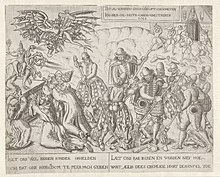
Back Reformatorischer Bildersturm ALS Іканаборскае паўстанне Byelorussian Reformatorischer Bildersturm German Beeldenstorm Greek Beeldenstorm Spanish Pildirüüste Estonian طوفان شمایل Persian Furie iconoclaste French Byldestoarm Frisian Beeldenstorm Galician

Beeldenstorm (pronounced [ˈbeːldə(n)ˌstɔr(ə)m]) in Dutch and Bildersturm [ˈbɪldɐˌʃtʊʁm] in German (roughly translatable from both languages as 'attack on the images or statues') are terms used for outbreaks of destruction of religious images that occurred in Europe in the 16th century, known in English as the Great Iconoclasm or Iconoclastic Fury.[2] During these spates of iconoclasm, Catholic art and many forms of church fittings and decoration were destroyed in unofficial or mob actions by Calvinist Protestant crowds as part of the Protestant Reformation.[3][4] Most of the destruction was of art in churches and public places.[5]

The Dutch term usually specifically refers to the wave of disorderly attacks in the summer of 1566 that spread rapidly through the Low Countries from south to north. Similar outbreaks of iconoclasm took place in other parts of Europe, especially in Switzerland and the Holy Roman Empire in the period between 1522 and 1566, notably Zürich (in 1523), Copenhagen (1530), Münster (1534), Geneva (1535), and Augsburg (1537).[6]
In England, there was both government-sponsored removal of images and also spontaneous attacks from 1535 onwards, and in Scotland from 1559.[6] In France, there were several outbreaks as part of the Wars of Religion from 1560 onwards.
- ^ analysed in Arnade, 146 (quoted); see also Art through time Archived 2016-03-03 at the Wayback Machine
- ^ in French as the Furie iconoclaste
- ^ Cite error: The named reference
Marshall2009was invoked but never defined (see the help page). - ^ Byfield, Ted (2002). A Century of Giants, A.D. 1500 to 1600: In an Age of Spiritual Genius, Western Christendom Shatters. Christian History Project. p. 297. ISBN 9780968987391.
Devoutly Catholic but opposed to Inquisition tactics, they backed William of Orange in subduing the Calvinist uprising of the Dutch beeldenstorm on behalf of regent Margaret of Parma, and had come willingly to the council at her invitation.
- ^ Cite error: The named reference
Kleiner2010was invoked but never defined (see the help page). - ^ a b John Phillips, Reformation of Images: Destruction of Art in England, 1535–1660, (Berkeley: University of California Press) 1973.